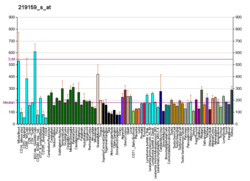SLAMF7
Protein-coding gene in humans
| SLAMF7 | |||||||||||||||||||||||||||||||||||||||||||||||||||
|---|---|---|---|---|---|---|---|---|---|---|---|---|---|---|---|---|---|---|---|---|---|---|---|---|---|---|---|---|---|---|---|---|---|---|---|---|---|---|---|---|---|---|---|---|---|---|---|---|---|---|---|
| Identifiers | |||||||||||||||||||||||||||||||||||||||||||||||||||
| Aliases | SLAMF7, 19A, CD319, CRACC, CS1, SLAM family member 7 | ||||||||||||||||||||||||||||||||||||||||||||||||||
| External IDs | OMIM: 606625; MGI: 1922595; HomoloGene: 49660; GeneCards: SLAMF7; OMA:SLAMF7 - orthologs | ||||||||||||||||||||||||||||||||||||||||||||||||||
| |||||||||||||||||||||||||||||||||||||||||||||||||||
| |||||||||||||||||||||||||||||||||||||||||||||||||||
| |||||||||||||||||||||||||||||||||||||||||||||||||||
| |||||||||||||||||||||||||||||||||||||||||||||||||||
| |||||||||||||||||||||||||||||||||||||||||||||||||||
| Wikidata | |||||||||||||||||||||||||||||||||||||||||||||||||||
| |||||||||||||||||||||||||||||||||||||||||||||||||||
SLAM family member 7 is a protein that in humans is encoded by the SLAMF7 gene.[5][6][7]
The surface antigen CD319 (SLAMF7) is a robust marker of normal plasma cells and malignant plasma cells in multiple myeloma. In contrast to CD138 (the traditional plasma cell marker), CD319/SLAMF7 is much more stable and allows robust isolation of malignant plasma cells from delayed or even cryopreserved samples.[8]
Elotuzumab is an antibody that targets this protein.
References
- ^ a b c GRCh38: Ensembl release 89: ENSG00000026751 – Ensembl, May 2017
- ^ a b c GRCm38: Ensembl release 89: ENSMUSG00000038179 – Ensembl, May 2017
- ^ "Human PubMed Reference:". National Center for Biotechnology Information, U.S. National Library of Medicine.
- ^ "Mouse PubMed Reference:". National Center for Biotechnology Information, U.S. National Library of Medicine.
- ^ Murphy JJ, Hobby P, Vilarino-Varela J, Bishop B, Iordanidou P, Sutton BJ, Norton JD (Feb 2002). "A novel immunoglobulin superfamily receptor (19A) related to CD2 is expressed on activated lymphocytes and promotes homotypic B-cell adhesion". The Biochemical Journal. 361 (Pt 3): 431–6. doi:10.1042/0264-6021:3610431. PMC 1222324. PMID 11802771.
- ^ Boles KS, Mathew PA (Feb 2001). "Molecular cloning of CS1, a novel human natural killer cell receptor belonging to the CD2 subset of the immunoglobulin superfamily". Immunogenetics. 52 (3–4): 302–7. doi:10.1007/s002510000274. PMID 11220635. S2CID 39567095.
- ^ "Entrez Gene: SLAMF7 SLAM family member 7".
- ^ Frigyesi I, Adolfsson J, Ali M, Christophersen MK, Johnsson E, Turesson I, Gullberg U, Hansson M, Nilsson B (Feb 2014). "Robust isolation of malignant plasma cells in multiple myeloma". Blood. 123 (9): 1336–40. doi:10.1182/blood-2013-09-529800. PMID 24385542.
Further reading
- Claus M, Meinke S, Bhat R, Watzl C (2007). "Regulation of NK cell activity by 2B4, NTB-A and CRACC". Frontiers in Bioscience. 13 (13): 956–65. doi:10.2741/2735. PMID 17981603.
- Hartley JL, Temple GF, Brasch MA (Nov 2000). "DNA cloning using in vitro site-specific recombination". Genome Research. 10 (11): 1788–95. doi:10.1101/gr.143000. PMC 310948. PMID 11076863.
- Wiemann S, Weil B, Wellenreuther R, Gassenhuber J, Glassl S, Ansorge W, Böcher M, Blöcker H, Bauersachs S, Blum H, Lauber J, Düsterhöft A, Beyer A, Köhrer K, Strack N, Mewes HW, Ottenwälder B, Obermaier B, Tampe J, Heubner D, Wambutt R, Korn B, Klein M, Poustka A (Mar 2001). "Toward a catalog of human genes and proteins: sequencing and analysis of 500 novel complete protein coding human cDNAs". Genome Research. 11 (3): 422–35. doi:10.1101/gr.GR1547R. PMC 311072. PMID 11230166.
- Bouchon A, Cella M, Grierson HL, Cohen JI, Colonna M (Nov 2001). "Activation of NK cell-mediated cytotoxicity by a SAP-independent receptor of the CD2 family". Journal of Immunology. 167 (10): 5517–21. doi:10.4049/jimmunol.167.10.5517. PMID 11698418.
- Tovar V, del Valle J, Zapater N, Martin M, Romero X, Pizcueta P, Bosch J, Terhorst C, Engel P (Sep 2002). "Mouse novel Ly9: a new member of the expanding CD150 (SLAM) family of leukocyte cell-surface receptors". Immunogenetics. 54 (6): 394–402. doi:10.1007/s00251-002-0483-3. PMID 12242590. S2CID 38277782.
- Del Valle JM, Engel P, Martín M (May 2003). "The cell surface expression of SAP-binding receptor CD229 is regulated via its interaction with clathrin-associated adaptor complex 2 (AP-2)". The Journal of Biological Chemistry. 278 (19): 17430–7. doi:10.1074/jbc.M301569200. PMID 12621057.
- Zhang Z, Henzel WJ (Oct 2004). "Signal peptide prediction based on analysis of experimentally verified cleavage sites". Protein Science. 13 (10): 2819–24. doi:10.1110/ps.04682504. PMC 2286551. PMID 15340161.
- Lee JK, Boles KS, Mathew PA (Oct 2004). "Molecular and functional characterization of a CS1 (CRACC) splice variant expressed in human NK cells that does not contain immunoreceptor tyrosine-based switch motifs". European Journal of Immunology. 34 (10): 2791–9. doi:10.1002/eji.200424917. PMID 15368295.
- Wiemann S, Arlt D, Huber W, Wellenreuther R, Schleeger S, Mehrle A, Bechtel S, Sauermann M, Korf U, Pepperkok R, Sültmann H, Poustka A (Oct 2004). "From ORFeome to biology: a functional genomics pipeline". Genome Research. 14 (10B): 2136–44. doi:10.1101/gr.2576704. PMC 528930. PMID 15489336.
- Mehrle A, Rosenfelder H, Schupp I, del Val C, Arlt D, Hahne F, Bechtel S, Simpson J, Hofmann O, Hide W, Glatting KH, Huber W, Pepperkok R, Poustka A, Wiemann S (Jan 2006). "The LIFEdb database in 2006". Nucleic Acids Research. 34 (Database issue): D415-8. doi:10.1093/nar/gkj139. PMC 1347501. PMID 16381901.
- Stark S, Watzl C (Feb 2006). "2B4 (CD244), NTB-A and CRACC (CS1) stimulate cytotoxicity but no proliferation in human NK cells". International Immunology. 18 (2): 241–7. doi:10.1093/intimm/dxh358. PMID 16410313.
- Lee JK, Mathew SO, Vaidya SV, Kumaresan PR, Mathew PA (Oct 2007). "CS1 (CRACC, CD319) induces proliferation and autocrine cytokine expression on human B lymphocytes". Journal of Immunology. 179 (7): 4672–8. doi:10.4049/jimmunol.179.7.4672. PMID 17878365.
- Malaer JD, Mathew PA (Aug 2017). "CS1 (SLAMF7, CD319) is an effective immunotherapeutic target for multiple myeloma". American Journal of Cancer Research. 7 (8): 1637–41. PMC 5574936. PMID 28861320.
- v
- t
- e



















